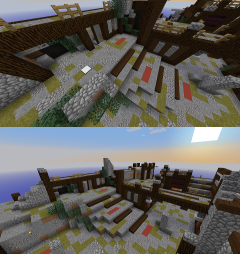There are three components to a map submitted through a forum post:
- An image album
- A description
- A download
 A bad example and a good example.
A bad example and a good example.Having a poorly shot image album can really hurt your chances of getting your map noticed. Here are a few pointers for choosing what to show and how to show it:
- F1 to hide the GUI
- Normal FOV (70)
- Default texture pack, which is what most players will be using anyways
- As few images as possible that show the whole map
- Start with a top down "birds-eye" view of the map, and experiment with the exact angle
- When possible, show multiple key features (especially include one already shown) so the viewer can orient themselves with each image
For your description, identify and explain your major design decisions. Even if you're wrong about things, whoever's judging your submission will have a better idea as to your intent if the map doesn't play well.
For maps that aren't being submitted for review and are being posted for individual use, make sure to keep your blurb focused on a “hook” that makes your map unique, rather than getting especially technical. Also, make sure that your images show the best features of the map, but are varied enough such that anyone viewing would want to see more.
For your map download, be sure to prune the map folder by using MCEdit to delete unused chunks, and remove all files except for the level.dat, region folder, and xml/json file if it's included. Click here for a visual guide on using MCEdit to prune your map.
Once submitted, reception of a map as it goes through review can be categorized one of three things:
- Total silence
- When your map gets no response from anyone handling submissions, it's likely because your lack of experience is visible and the only reasonable advice to give would be for you to work on the basics. This can be incredibly frustrating, as many of your first attempts will not be recognized, but it's very important to keep improving by just starting over until you can build up enough experience.
- Harsh criticism
- In essence, whoever's judging doesn't see much potential in your map, but they see potential in you as a mapmaker. They'll tear your map apart, sometimes with more information than you can make use of at the time. It's important to pick out criticisms of your core concepts and focus on learning from those rather than trying to fix any nitpicks. Once again, at this stage it's often better to start over than it is to fundamentally change a completed map.
- Minor criticism (or acceptance)
- This is the point where criticism is either entirely fixable or not needed at all. Your map is good enough to be at least tried, and so you start to work with whoever's handling your submission on improving and implementing the map.
In the case that you're sending a map for review or feedback through a direct message, there are a few things to keep in mind. Most importantly, not everyone will have the time or interest to help you. Silence, “not right now”, and “ask this person instead”, are all roundabout ways of saying no that mean you should move on and ask someone else. Second, when someone does help, they are not necessarily committing to further help. Repeatedly messaging someone who does not respond to you or becoming reliant on someone who has is not professional, and won't get you farther.
Back to Intro Last: Aesthetics